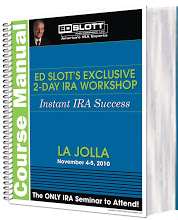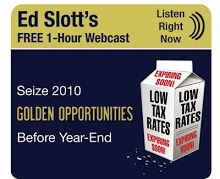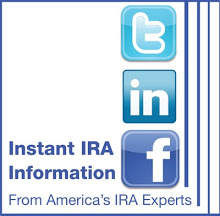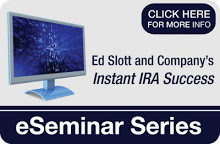We have three questions from consumers in this week's installment after receiving an abundance of great questions over the course of the last seven days.
We keep all questions on file and will try to include them in an upcoming installment if they are still current.
Also, take some time over the next several days to browse our NEW website, which has a lot of interactive features (including this mailbag, The Slott Report, Retirement Fears and the discussion forum), informative videos and important IRA resources for both consumers and advisors.
Now, on with the questions.
1.
I have terminated employment and have 401(k) assets for distribution. The company matched 70% of my contributions up to 6% of compensation. My contributions consisted of 3% pre-tax and 3% after-tax. If I take a lump-sum distribution, can I roll the after-tax contributions to a Roth IRA and the rest to a regular IRA?
Thanks for your help,
Carl Bode
Answer:
Yes. You can roll the after-tax dollars into a Roth if your adjusted gross income does not exceed $100,000 in 2009. If you convert in 2010 the $100,000 limit will not apply. If you are married and filing separate returns you can not do a Roth IRA.
2.
My wife and I both have 401K accounts from previous employers that we plan to rollover to IRA in 2009. For both of us, part of our 401K accounts include after-tax contributions. What is the best way to handle the after-tax money? Can it be put into a Roth IRA? How do I handle the tax forms on the rollover of the after-tax funds? Our total AGI for 2008 will be over $250,000, but since we are both now self-employed our income in 2009 is unknown, but could be considerably less. I love your book, "Time Bomb", but can't find an answer to this specific question. Thanks, I'll look for an answer in your report.
Mike Schaffnercell
Answer:
You have several options:
1. If the after tax amount is small you might just want to take it out, no income tax due, and spend it.
2. If you receive separate checks, one for pre-tax and one for after-tax dollars, you can consider a Roth IRA. You can do the Roth in 2009 if your income does not exceed $100,000. In 2010 the $100,000 limit will not apply. If you and you wife are filing separate returns you will not be able to do a Roth IRA.
3. You could put the after-tax money in a traditional IRA and when you take distributions it will lower you tax bill. You will have to pro-rate between the pre-tax and after-tax money. This would the most difficult option.
On form 1099 R the entire amount of the distribution will go into box 1. In box 2a, it will show just the taxable amount. In box 7 the code will be G which indicates a direct rollover.
3.
Ed Slott & Company,
I am now retired, and I want to do a direct rollover from my 401k to my IRA. However, the custodian of my 401k says that any disbursements from my 401k must be mailed directly to my current address. The 401k custodian says the disbursement check can be made payable to whoever I wish, and, of course, I can re-ail the check to the new custodian once I receive it.
But, will the IRS see this as a direct rollover since the check to the new custodian passes through my hands first? Do I need to do anything special to make sure nothing goes wrong with a transfer like this?
Thanks,
Jay Orman
Answer:
The check payable to your new custodian and sent to you is considered a direct rollover. There will be no 20% withholding. We would recommend that after you send the check to the new custodian you confirm that they received it and it was in fact put into an IRA account.
Thursday, February 26, 2009
Tuesday, February 24, 2009
Happy New Year From Congress and the IRS
On December 23, 2008 President Bush signed into law the Workers, Retiree & Employee Recovery Act of 2008 which eliminates having to take RMDs for 2009 only.
As a general rule, if you are a participant in a qualified retirement plan or an IRA owner and are over age 70 ½, you must take required distributions (RMDs) each and every year until your account balance is depleted or you die. This also applies to beneficiaries of inherited plans or IRAs. But under this new law, account owners and beneficiaries will not have to take an RMD in 2009. The 50% penalty for not taking a 2009 RMD will not apply for 2009.
The annual RMD is always based on the prior 12/31 market value of your plan balance and your life expectancy factor which is based on your attained age for the year. The life expectancy factors are found in IRS Publication 590. Individuals having to take RMDs in 2008 had to take them based on the December 31, 2007 market value. On December 31, 2007, if your plan assets were invested in stocks, the value of your assets were generally much higher than the value in 2008. Therefore, in 2008 you were forced to take out a greater amount based on the larger December 31, 2007 values and, in fact, the asset value could have declined by 50% or more by the time you took the distribution. Thus Congress felt that there should be some relief. You would have thought that Congress would have done something for tax year 2008. However, the law was passed in December, 2008 and it would have been virtually impossible to go back, so they chose to go forward and provide relief for 2009.
This one year exception to taking RMDs does not apply to all plans. It generally does not apply to defined benefit plans or other plans that have been annuitized. These plans have no investment risk and Congress felt they had not suffered from the market decline. It generally applies to accounts mentioned above including 403(a), 403(b), 457(b), 401(k) and profit sharing plans. All of these types of plans may be subject to market risk.
The RMD exception for 2009 does not apply to IRA owners who turned age 70 ½ in 2008 and who deferred their RMD to April 1, 2009. This is a 2008 distribution and it still must be taken.
It is interesting to conjecture whether not taking RMDs in 2009 will be of any benefit if your money remains invested in stocks. It is possible that the market value could be even lower in 2010, in which case you would have saved money by taking the RMD out in 2009. What we do know is that by not taking any money in 2009 you will not incur income tax that would normally be due on distributions. However, will income tax rates be higher in 2010 and beyond?
While it could be advantageous not to take a distribution in 2009, there is at least one reason, other than if you need the money to live on, to consider taking a distribution and that would be giving the distribution to charity.
In 2009 you are allowed to take money out of your IRA (not employer plan) and give it to your favorite charity and pay no income tax on the distribution. The IRS calls this a Qualified Charitable Distribution (QCD). There are certain requirements that must be met in order to qualify:
1. You must be age 70 ½ or older on the date of transfer.
2. It must be directly from the IRA to the charity. You could receive it and then give it to charity but it can not be payable to you.
3. The maximum amount you can give in 2009 that is not included in income is $100,000 per IRA owner. You could give more but any amount over $100,000 will be subject to income tax.
You will not receive a charitable tax deduction on your income tax return for the amount given to charity from your IRA in 2009. There is no income being reported (up to $100,000) so there is no offsetting deduction.
If an individual age 70 ½ or older is using the standard itemized deduction on their 2009 tax return and giving a donation to charity, other than from the IRA, they do not receive a tax deduction. The standard itemized deduction for joint filers in 2009 is $11,400 plus an additional $1,400 if you are over age 65. For this individual, making the charitable donation from the IRA would represent a large income tax saving because that amount is not included in income. This is a great way to satisfy philanthropic desires and save taxes. The QCD is due to expire on December 31, 2009.
Deciding not to take any RMD or a portion of it in 2009 is a decision that should not be made without consulting your accountant or financial adviser.
*2009 Copyright Ed Slott and Company, LLC
As a general rule, if you are a participant in a qualified retirement plan or an IRA owner and are over age 70 ½, you must take required distributions (RMDs) each and every year until your account balance is depleted or you die. This also applies to beneficiaries of inherited plans or IRAs. But under this new law, account owners and beneficiaries will not have to take an RMD in 2009. The 50% penalty for not taking a 2009 RMD will not apply for 2009.
The annual RMD is always based on the prior 12/31 market value of your plan balance and your life expectancy factor which is based on your attained age for the year. The life expectancy factors are found in IRS Publication 590. Individuals having to take RMDs in 2008 had to take them based on the December 31, 2007 market value. On December 31, 2007, if your plan assets were invested in stocks, the value of your assets were generally much higher than the value in 2008. Therefore, in 2008 you were forced to take out a greater amount based on the larger December 31, 2007 values and, in fact, the asset value could have declined by 50% or more by the time you took the distribution. Thus Congress felt that there should be some relief. You would have thought that Congress would have done something for tax year 2008. However, the law was passed in December, 2008 and it would have been virtually impossible to go back, so they chose to go forward and provide relief for 2009.
This one year exception to taking RMDs does not apply to all plans. It generally does not apply to defined benefit plans or other plans that have been annuitized. These plans have no investment risk and Congress felt they had not suffered from the market decline. It generally applies to accounts mentioned above including 403(a), 403(b), 457(b), 401(k) and profit sharing plans. All of these types of plans may be subject to market risk.
The RMD exception for 2009 does not apply to IRA owners who turned age 70 ½ in 2008 and who deferred their RMD to April 1, 2009. This is a 2008 distribution and it still must be taken.
It is interesting to conjecture whether not taking RMDs in 2009 will be of any benefit if your money remains invested in stocks. It is possible that the market value could be even lower in 2010, in which case you would have saved money by taking the RMD out in 2009. What we do know is that by not taking any money in 2009 you will not incur income tax that would normally be due on distributions. However, will income tax rates be higher in 2010 and beyond?
While it could be advantageous not to take a distribution in 2009, there is at least one reason, other than if you need the money to live on, to consider taking a distribution and that would be giving the distribution to charity.
In 2009 you are allowed to take money out of your IRA (not employer plan) and give it to your favorite charity and pay no income tax on the distribution. The IRS calls this a Qualified Charitable Distribution (QCD). There are certain requirements that must be met in order to qualify:
1. You must be age 70 ½ or older on the date of transfer.
2. It must be directly from the IRA to the charity. You could receive it and then give it to charity but it can not be payable to you.
3. The maximum amount you can give in 2009 that is not included in income is $100,000 per IRA owner. You could give more but any amount over $100,000 will be subject to income tax.
You will not receive a charitable tax deduction on your income tax return for the amount given to charity from your IRA in 2009. There is no income being reported (up to $100,000) so there is no offsetting deduction.
If an individual age 70 ½ or older is using the standard itemized deduction on their 2009 tax return and giving a donation to charity, other than from the IRA, they do not receive a tax deduction. The standard itemized deduction for joint filers in 2009 is $11,400 plus an additional $1,400 if you are over age 65. For this individual, making the charitable donation from the IRA would represent a large income tax saving because that amount is not included in income. This is a great way to satisfy philanthropic desires and save taxes. The QCD is due to expire on December 31, 2009.
Deciding not to take any RMD or a portion of it in 2009 is a decision that should not be made without consulting your accountant or financial adviser.
*2009 Copyright Ed Slott and Company, LLC
Friday, February 20, 2009
The Slott Report Mailbag: February 19th
We have two more questions for all of our consumers this week. If you haven't checked, http://www.irahelp.com/ is NEW and IMPROVED so click on the link and navigate our new website for advisors and consumers.
This week's mailbag is below.
1) I am still employed full time, but have reached the age when I must take a minimum distribution from my 403(b) prior to April 1. Can I still contribute to a 403(b) -- and what should be my next steps? Please help.
Josephine Murray
Answer:
Your required minimum distribution (RMD) that has to be taken by 4/1/09 is for year 2008 and must be taken. In 2009 you will not have to take a RMD if you don't need the money. There will be no penalty imposed so you can take nothing or as much as you want. And, yes you can contribute to your 403 (b) over age 70 1/2 . You might however want to check the 403 (b) plan document for eligibility.
2) I am 67 and just retired (definitely not on the Golden Pond). I have a 401(k) which I will be dependant upon for income (have only Social Security and very small monthly retirement from work). Can I set up a Roth IRA that has guaranteed returns within 6 months? Is there an account that has self-regulated (non-punishable) withdrawals?
Pete Murphy
Answer:
If you have earned income you can contribute to a Roth IRA if your joint income is less than $166,00 in 2009, assuming you are filling a joint return. If your joint income is greater than $166,000, the contribution to the Roth will start to phase out. Meaning you will be able to contribute but a lesser amount than $5,000. If your joint income exceeds $176,000 you will not be able to contribute.
If you take a distribution from your 401(k) plan you could do a Roth IRA if your income doesn't exceed $100,000 in 2009. You will have to pay the income tax on all the pre-tax money being converted. If however you do the Roth in year 2010 the $100,000 limit goes away and you can pay the income tax due over years 2011 and 2012.
You can take tax-free withdrawals from the Roth up to the amount you convert. The first money coming out will be the converted amount and after that it will be the income earned. If you get to the income you will have to wait five years to take it penalty free.
For guaranteed returns, other than bank CDs, you should consult your financial advisor. Before taking some of your 401(k) to do a Roth IRA please also consult your accountant or financial advisor. The rules are very complicated.
This week's mailbag is below.
1) I am still employed full time, but have reached the age when I must take a minimum distribution from my 403(b) prior to April 1. Can I still contribute to a 403(b) -- and what should be my next steps? Please help.
Josephine Murray
Answer:
Your required minimum distribution (RMD) that has to be taken by 4/1/09 is for year 2008 and must be taken. In 2009 you will not have to take a RMD if you don't need the money. There will be no penalty imposed so you can take nothing or as much as you want. And, yes you can contribute to your 403 (b) over age 70 1/2 . You might however want to check the 403 (b) plan document for eligibility.
2) I am 67 and just retired (definitely not on the Golden Pond). I have a 401(k) which I will be dependant upon for income (have only Social Security and very small monthly retirement from work). Can I set up a Roth IRA that has guaranteed returns within 6 months? Is there an account that has self-regulated (non-punishable) withdrawals?
Pete Murphy
Answer:
If you have earned income you can contribute to a Roth IRA if your joint income is less than $166,00 in 2009, assuming you are filling a joint return. If your joint income is greater than $166,000, the contribution to the Roth will start to phase out. Meaning you will be able to contribute but a lesser amount than $5,000. If your joint income exceeds $176,000 you will not be able to contribute.
If you take a distribution from your 401(k) plan you could do a Roth IRA if your income doesn't exceed $100,000 in 2009. You will have to pay the income tax on all the pre-tax money being converted. If however you do the Roth in year 2010 the $100,000 limit goes away and you can pay the income tax due over years 2011 and 2012.
You can take tax-free withdrawals from the Roth up to the amount you convert. The first money coming out will be the converted amount and after that it will be the income earned. If you get to the income you will have to wait five years to take it penalty free.
For guaranteed returns, other than bank CDs, you should consult your financial advisor. Before taking some of your 401(k) to do a Roth IRA please also consult your accountant or financial advisor. The rules are very complicated.
Thursday, February 12, 2009
The Slott Report Mailbag: February 12th
Love is in the air, and consumers are worried about protecting their loved ones deep into retirement. We received a very in-depth question from one consumer this week (question and answer below). It covered so many subjects that we decided to showcase it alone in this week's installment. Many of you may have questions that touch at one, or even several, of the subjects discussed below.
Question:
Ed and Company,
I'm reading your book "The Retirement Savings Time Bomb... And How to Defuse It" and hoping it will answer my questions regarding conversion to Roth IRA when the eligibility rules are relaxed in 2010.
First, to confirm - the pro-rata rule counts only IRA assets (correct?). By moving IRA assets to a 401k, they are removed from the calculation. It seems the IRS changed the rules with EGTRRA 2001 allowing transfers between different types of retirement plans, but they did not add 401k assets into the pro-rata rule. Did the IRS really leave a loophole here?
Secondly, I'd like to know timing requirements. Do the numbers that go into the pro-rata rule come from year-end balances (reported to the IRS by the IRA custodians of form 5498, I believe), or are they balances taken at some other point in time - such as the date when the transfer/rollover takes place? It may be a minor point, but this might require action in 2009 (rolling some assets from IRA to 401k) in order to set up more favorable pro-rata ratios for conversion from Traditional IRA to Roth IRA in 2010, if they are based on year-end 2009 balances.
Finally, I would of course confirm that my company plan does allow for transfers in and out. Assuming they allow both of these, are there any timing requirements that I need to be aware of? As you advise, it is generally better to keep the assets in an IRA than in a company plan. So after completing the conversion to Roth, do I need to wait for some time before rolling the 401k balance back to an IRA? Should I wait till 2011, so year-end 2010 balances look a certain way? If I elect to carry taxable income from the conversion in 2010 to the following years 2011 and 2012, will this have any bearing? I'd like to do the right thing from an estate planning perspective, and would like to do this sooner rather than later. I will probably continue to convert some amount of IRA assets from Traditional to Roth each year thereafter, while staying within my current tax-bracket limit.
Thanks,
Peter
Answer:
The pro-rata rule that applies to your question in converting a traditional IRA to a Roth IRA is the pro-rata rule for IRAs. There is a separate pro-rata rule for 401(k) plans which does not apply to your question. The number that goes into the pro-rata rule will come from your 12/31 prior year-end statement. IRS form 8606 is used when after-tax money goes into an IRA and used anytime you take a distribution. The form is a working document on which you continue to build on. Form 5498 must be provided to a taxpayer prior to May 31st well after the 12/31/value you will use for a conversion.
Pre-tax money from an IRA can go into a 401(k) plan but not after-tax money. After transferring the pre-tax money you would be left with only the after-tax money. You must consult IRS form 8606 worksheet for the formula to determine any tax that may or may not be due on the conversion. Keep in mind, however, that a rollover from a Roth IRA to employer retirement plan is not allowed.
We are assuming that these transfers are direct transfers and not rollovers.
You have asked some very specific and highly technical questions and you should not attempt to complete these types of transactions without consulting your tax advisor and/or your accountant. The more complicated the transaction, the greater the possibility for an error to occur. You must ask yourself is all this work worth it to save a little income tax. It may be in the end.
Question:
Ed and Company,
I'm reading your book "The Retirement Savings Time Bomb... And How to Defuse It" and hoping it will answer my questions regarding conversion to Roth IRA when the eligibility rules are relaxed in 2010.
First, to confirm - the pro-rata rule counts only IRA assets (correct?). By moving IRA assets to a 401k, they are removed from the calculation. It seems the IRS changed the rules with EGTRRA 2001 allowing transfers between different types of retirement plans, but they did not add 401k assets into the pro-rata rule. Did the IRS really leave a loophole here?
Secondly, I'd like to know timing requirements. Do the numbers that go into the pro-rata rule come from year-end balances (reported to the IRS by the IRA custodians of form 5498, I believe), or are they balances taken at some other point in time - such as the date when the transfer/rollover takes place? It may be a minor point, but this might require action in 2009 (rolling some assets from IRA to 401k) in order to set up more favorable pro-rata ratios for conversion from Traditional IRA to Roth IRA in 2010, if they are based on year-end 2009 balances.
Finally, I would of course confirm that my company plan does allow for transfers in and out. Assuming they allow both of these, are there any timing requirements that I need to be aware of? As you advise, it is generally better to keep the assets in an IRA than in a company plan. So after completing the conversion to Roth, do I need to wait for some time before rolling the 401k balance back to an IRA? Should I wait till 2011, so year-end 2010 balances look a certain way? If I elect to carry taxable income from the conversion in 2010 to the following years 2011 and 2012, will this have any bearing? I'd like to do the right thing from an estate planning perspective, and would like to do this sooner rather than later. I will probably continue to convert some amount of IRA assets from Traditional to Roth each year thereafter, while staying within my current tax-bracket limit.
Thanks,
Peter
Answer:
The pro-rata rule that applies to your question in converting a traditional IRA to a Roth IRA is the pro-rata rule for IRAs. There is a separate pro-rata rule for 401(k) plans which does not apply to your question. The number that goes into the pro-rata rule will come from your 12/31 prior year-end statement. IRS form 8606 is used when after-tax money goes into an IRA and used anytime you take a distribution. The form is a working document on which you continue to build on. Form 5498 must be provided to a taxpayer prior to May 31st well after the 12/31/value you will use for a conversion.
Pre-tax money from an IRA can go into a 401(k) plan but not after-tax money. After transferring the pre-tax money you would be left with only the after-tax money. You must consult IRS form 8606 worksheet for the formula to determine any tax that may or may not be due on the conversion. Keep in mind, however, that a rollover from a Roth IRA to employer retirement plan is not allowed.
We are assuming that these transfers are direct transfers and not rollovers.
You have asked some very specific and highly technical questions and you should not attempt to complete these types of transactions without consulting your tax advisor and/or your accountant. The more complicated the transaction, the greater the possibility for an error to occur. You must ask yourself is all this work worth it to save a little income tax. It may be in the end.
Monday, February 9, 2009
Reminder: Webcast This Wednesday!
As a reminder, we would like to make you aware that Ed Slott's FREE 1-hour Webcast, The Largest IRA Rollovers Are Everywhere! How to Turn This Unprecedented Opportunity Into New Business For You!, will take place this Wednesday, February 11th, 2009 at 4:00 p.m. ET.
You can sign up for the webcast by clicking this link. You will receive a confirmation e-mail upon registering and an e-mail with detailed access instructions in the days preceding the webcast.
Again, Ed Slott's first Webcast is Wednesday, February 11th at 4:00 p.m. ET. You can register for the webcast and other webcast dates at the following address: http://www.irahelp.com/webcast_reg/ or just click on the webcast image in the top left-hand corner of The Slott Report.
You can sign up for the webcast by clicking this link. You will receive a confirmation e-mail upon registering and an e-mail with detailed access instructions in the days preceding the webcast.
Again, Ed Slott's first Webcast is Wednesday, February 11th at 4:00 p.m. ET. You can register for the webcast and other webcast dates at the following address: http://www.irahelp.com/webcast_reg/ or just click on the webcast image in the top left-hand corner of The Slott Report.
Thursday, February 5, 2009
The Slott Report Mailing: February 5
We received a record amount of questions for this week's mailbag, and have selected two that are answered in this space. Remember to check back each week because we save questions and may answer them in an upcoming installment.
1.
Hello,
I read CalcXML (google search) about converting traditional IRAs to Roth IRAs after reading a book by Ed Slott. CalcXML said “…Please note that beginning in 2010 the $100,000 adjusted gross income limit for conversion to Roth IRAs is permanently repealed. From 2010 onward, all taxpayers, regardless of income, can convert to Roth IRAs. Also, for conversions occurring in 2010, the taxpayer will only have to report one-half of taxable income in 2011 and one-half in 2012. After 2010, conversions must be reported in full in the taxable year in which they are made.” Does this mean that it is better to convert in 2010? I make $36,000 a yr at 58 and have no 401K, no 403b and only 20,0000 of IRAs (all traditional) and SS for retirement. Even so, it matters to me as a divorced woman with three children and wanting to follow the PBS Ed Slott program, so that I can leave the most possible to my children. It matters to me a lot. Yet, I did a google search today and got this. What does that quotation mean? It looks like it is better to convert in 2010, though it is possible to convert now and get it completed. Certainly, it does not mean it the way that it looks like?
Please address this statement and what it really means.
Thanks,
Mary Beth
Answer:
Mary Beth,
You have done a good job on your research and your facts are correct. Based on your facts, you can convert from a traditional IRA to a Roth IRA anytime you would like to. As you stated, if you convert to a Roth IRA in year 2010 you would be able to spread the income tax due on the conversion over years 2011 & 2012. If you convert to a Roth while the value of your traditional IRA is low you will pay less income tax on the conversion. Waiting for year 2010 to convert you may have a higher value or a lower value, however you can then spread the income tax due over years 2011 & 2012. We know what the income tax rates are today but we do not know what they will be in year 2010, they could be higher. A Roth IRA has many advantages but the timing of the conversion is very difficult to determine.
2.
Dear Ed and Company,
I am confused about taking my first RMD. I turned 70 ½ in February 2008. I know I had until April 2009 to take my first RMD, but I took it before December 31, 2008 so as not to have two distributions in one year. Now that there is no RMD for 2009, I think I did the wrong thing. Is the distribution I took considered to be for 2008 and still required or is it for 2009 and not required?
I am within the 60-day rollover time so I can still roll it over and put it back into an IRA.
P.S. You know my wife and have helped us before regarding the stepped up basis on her parents’ home.
Thanks for your assistance again,
Allan Appel
Answer:
Allan,
You are correct that your first required minimum distribution (RMD) is for tax year 2008. Yes you could have waited until April 1st, 2009 to take it. However, since you did take it in 2008 it will be counted as income in 2008. The IRS rules will not allow you to put it back or roll it over to another IRA and then take it out as a RMD in 2009 for your 2008 RMD. If you don't take any money out of your IRA in 2009, which is now permitted, you would not have any income from your IRA to report for your 2009 tax return.
1.
Hello,
I read CalcXML (google search) about converting traditional IRAs to Roth IRAs after reading a book by Ed Slott. CalcXML said “…Please note that beginning in 2010 the $100,000 adjusted gross income limit for conversion to Roth IRAs is permanently repealed. From 2010 onward, all taxpayers, regardless of income, can convert to Roth IRAs. Also, for conversions occurring in 2010, the taxpayer will only have to report one-half of taxable income in 2011 and one-half in 2012. After 2010, conversions must be reported in full in the taxable year in which they are made.” Does this mean that it is better to convert in 2010? I make $36,000 a yr at 58 and have no 401K, no 403b and only 20,0000 of IRAs (all traditional) and SS for retirement. Even so, it matters to me as a divorced woman with three children and wanting to follow the PBS Ed Slott program, so that I can leave the most possible to my children. It matters to me a lot. Yet, I did a google search today and got this. What does that quotation mean? It looks like it is better to convert in 2010, though it is possible to convert now and get it completed. Certainly, it does not mean it the way that it looks like?
Please address this statement and what it really means.
Thanks,
Mary Beth
Answer:
Mary Beth,
You have done a good job on your research and your facts are correct. Based on your facts, you can convert from a traditional IRA to a Roth IRA anytime you would like to. As you stated, if you convert to a Roth IRA in year 2010 you would be able to spread the income tax due on the conversion over years 2011 & 2012. If you convert to a Roth while the value of your traditional IRA is low you will pay less income tax on the conversion. Waiting for year 2010 to convert you may have a higher value or a lower value, however you can then spread the income tax due over years 2011 & 2012. We know what the income tax rates are today but we do not know what they will be in year 2010, they could be higher. A Roth IRA has many advantages but the timing of the conversion is very difficult to determine.
2.
Dear Ed and Company,
I am confused about taking my first RMD. I turned 70 ½ in February 2008. I know I had until April 2009 to take my first RMD, but I took it before December 31, 2008 so as not to have two distributions in one year. Now that there is no RMD for 2009, I think I did the wrong thing. Is the distribution I took considered to be for 2008 and still required or is it for 2009 and not required?
I am within the 60-day rollover time so I can still roll it over and put it back into an IRA.
P.S. You know my wife and have helped us before regarding the stepped up basis on her parents’ home.
Thanks for your assistance again,
Allan Appel
Answer:
Allan,
You are correct that your first required minimum distribution (RMD) is for tax year 2008. Yes you could have waited until April 1st, 2009 to take it. However, since you did take it in 2008 it will be counted as income in 2008. The IRS rules will not allow you to put it back or roll it over to another IRA and then take it out as a RMD in 2009 for your 2008 RMD. If you don't take any money out of your IRA in 2009, which is now permitted, you would not have any income from your IRA to report for your 2009 tax return.
The Distribution Holiday
Ed Slott wrote a February article that appears on Investment News' website, in which he discusses the ins and outs of The Worker, Retiree, and Employer Recovery Act of 2008. You can click here to access the entire article, and some highlights of the article are discussed below.
- Many retirees were hoping that RMDs would be suspended for 2008 since the declining stock market reduced the value of individual retirement accounts and 401(k)s. However, no such relief was granted.
- RMDs are calculated based on the prior year-end market value. For 2008, that means using the higher 2007 balance as of December 31, 2007, resulting in an RMD that was a higher part of the total balance than normal.
- There is NO relief for 2008, even if you turned age 70 1/2 in 2008 and are set to make the first RMD on April 1, 2009. Clients must still use the December 31, 2007 balance to compute a 2008 RMD taken in 2009.
- The suspension DOESN'T apply to all retirement distributions. It applies to distributions from IRAs and defined contribution plans like 401(k)s, 403(b)s and 457s, but NOT to defined benefit plans (one where the contribution amount is the amount needed to produce an annual benefit of a stated amount. The term describes traditional pension plans).
Subscribe to:
Posts (Atom)
